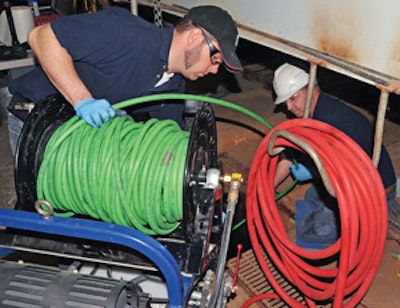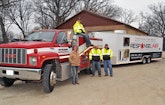Interested in Municipal/Industrial?
Get Municipal/Industrial articles, news and videos right in your inbox! Sign up now.
Municipal/Industrial + Get Alerts“We’re known as the technology leaders in our area,” says Saltzman, owner of First Response Service in Sandwich, Ill., which does business as First Response Drain Service. “It’s our claim to fame. No one else around here uses the technology we use.”
The company periodically does new-product testing for manufacturers. “Technology makes the world go around,” says Saltzman. “You can either shy away from it and live in the Stone Age or embrace it and improve productivity – and make life that much easier.”
Whether investing in a trailer-mounted waterjetter and nozzles, using an online data storage and distribution system, promoting trenchless pipe lining or using Facebook to attract new business, Saltzman is all about kicking old methods and equipment to the curb in favor of more productive technologies and techniques.
“When I run into old-timers, they think I’m nuts,” says Saltzman, 33. “But it’s fun to think outside the box. We’re not afraid to try new things. If something doesn’t work, it doesn’t work, and if nothing else, we learn a lesson and move forward.” So far, things are working well: Gross sales have doubled since the business began three years ago.
Diverse background
Saltzman didn’t plan on becoming a drain cleaner. After high school, he worked doing interior and exterior concrete work. Tired of winter layoffs, he went to work for an uncle, who is a plumber. His career took one small but fortuitous detour – a brief stint as a territorial sales manager for drain-cleaning equipment manufacturer Spartan Tool.
By selling equipment to and being in constant contact with drain cleaners, he saw the value of productivity-enhancing technology and the potential to make a nice living in a business niche for elite, technology-oriented service.
“When I was a plumber, I always enjoyed working on drains, and I realized there was a strong need for that in my area,” he recalls. “With the companies I used to work for, the best we could do was rod a drain and maybe camera a line, or dig up customers’ front lawns. I knew there had to be a better way.”
So Saltzman lit out on his own, equipped with a service van and a couple of small drum cable machines from Spartan. Saltzman credits the annual Pumper & Cleaner Environmental Expo for opening his eyes to a world of products and equipment. “It further underscored that there was some serious technology that could improve how we work in this industry,” he says. “After attending the show and educating myself, I went out and purchased equipment.”
Jetter jump-start
Saltzman’s first major purchase was an O’Brien 7030 trailer-mounted waterjetter (Hi-Vac Corp.) with a 700-gallon water tank, 600 feet of 3/4-inch hose, and a 3,000 psi/30 gpm pump. “We call it Zeus because it’s so big and powerful,” Saltzman says. “It has opened up new markets for us because we can do just about any cleaning that needs to be done. Once we used it to jet a 125-foot-long, 6-inch grease line, and there was no way we could do that with our old equipment.
“It’s got the same oomph as a lot of vacuum trucks. In fact, it’s one of the biggest trailer-mounted jetters on the market right now without going into a truck. There were competitors in my area who have this kind of equipment, but they focus on business in Chicago. So in our immediate area, I’m the only cleaner who uses one.”
Jetting business prompted Saltzman to hire a full-time employee. The unit brought so much business that taking on too much work became an issue. “There definitely was a learning curve,” he recalls. “We had to adapt to and learn how to use the equipment.”
Saltzman often invests in new nozzles for the jetter if they can help him enter a new market. For example, he recently bought a nozzle made by Enz USA that can descale an 8-inch boiler blowdown line at a local factory. Mineral deposits had clogged the line so badly that Saltzman couldn’t get a camera through it, but the nozzle did the trick, descaling a 150-foot stretch of pipe in a day.
“A couple of jobs like that will pay for the nozzle,” he says. “To help me decide if a nozzle like that is a good investment, I try to remember other business opportunities I may have passed up because I didn’t have that technology. And if there was no previous need for it, I try to gauge whether it will help open up another new market.”
The company also owns three Spartan drain machines (a heavy-duty 1065 model; a medium-sized 300; and a lightweight 100); two RIDGID SeeSnake inspection systems; a RIDGID SR60 pipe and utility locator; and a Big Brute cart jetter made by JETTERS NorthWest, a division of Seattle Pump & Equipment (3,500 psi/8.5 gpm).
Trenchless beckons
As his business grew, Saltzman repeatedly encountered customers with broken or collapsed laterals. He took to heart their complaints about expensive excavation work and embraced cured-in-place pipe (CIPP) lining. Just like the jetter, the investment in lining equipment from LMK Technologies wasn’t cheap. “But boy, does it pay off,” Saltzman notes. “Pipe lining increased our net profit by more than 30 percent per year. It’s by far the most profitable thing we do.”
The centerpiece of the lining process is a plastic bladder/felt liner – basically a long tube sock open on each end – which technicians saturate with a resin adhesive. They do that inside a wet-out trailer that is heated or air-conditioned, depending on the season. After the liner is saturated, crews roll it up and put it on a spindle inside an inversion tank, with one end sticking out of a nozzle.
“Then you cuff that end backwards onto the nozzle (on the inversion tank) and add air pressure, which inverts the liner inside-out as it enters the line, placing the wet side of the liner against the walls of the pipe. It’s sort of like blowing up a big circus balloon,” Saltzman says.
The difficult part of relining is the time constraint. The resin cures in about three hours at ambient temperature, so crews have to hustle butt to get the liner in proper position. “It’s kind of like pouring concrete in the summer,” Saltzman says. “That’s why it’s important to have all your ducks in a row.”
Crews can line up to 125 feet of 6-inch pipe at a time. They mostly repair laterals or sewer main sections. It’s not a hard sell because it’s usually cheaper than excavating and replacing pipes, not to mention less disruptive and destructive.
“I enjoy lining more than anything else we do because it’s something that not everybody can do, and it gives you such fulfillment to help customers without completely destroying their property,” Saltzman says. “We can rehabilitate 60 years of damage in half a day, make a fair profit, and know we’ve provided a good service for a customer.”
Social media shines
To market his services, Saltzman relies in part on a distinctive logo he designed. The logo, which plays off the emergency “star of life” symbol with a plunger substituted for the snake and staff, is prominently displayed on his 2004 GMC Savana Pro Series service truck, a GMC Topkick service vehicle (a converted rescue vehicle), the jetter, and the 30-foot wet-out trailer. It also appears on the company website.
“I used the star of life symbol to emphasize that these are emergency vehicles, to let people know we can take care of bad situations,” says Saltzman. But his real marketing passion is social networking, particularly Facebook, which he finds more effective than the website in generating business.
The Facebook page is a great way to network with potential customers. As of February, his page had 121 fans – not a huge number, but good for “a little company out in the middle of nowhere.”
Saltzman observes, “Networking and social media are a big thing for me. We’ve been working with a social networking coach. I know it sounds weird and crazy, but it’s the ultimate network. There’s nothing better.
“If we do something unique, like when we recently did a sectional repair of a 21-inch sewer main, we can post a video of it on our page. We share different things with those 121 people, and they, in turn, can share it with others. We expect those numbers to continue to grow.”
Saltzman used the Facebook page to promote a First Response exhibit at the county fair last September, where the company did lining demonstrations. “We’re still getting phone calls from people who saw that exhibit,” he says.
Best of all, Facebook is free. And he believes it’s better than a website because it’s interactive. People can post reviews and comments, or Saltzman can start a discussion about, say, experiences with sewer backups. That’s not possible with conventional advertising, like the Yellow Pages.
Future is here
“I don’t spend a whole lot of money on the Yellow Pages any more,” Saltzman says. “I’m putting all my chips on social marketing and media. To me, that’s where it’s at. I’d rather have people see us on a real level – see what we’re actually capable of doing, like lining installations, for example.
“It’s a great way to share what we do, and maybe down the line, they remember us the next time they have a problem. We’ve gotten job leads from it.”
Saltzman expects social media to become more and more pervasive in marketing. He sees many companies inviting consumers to follow them on Facebook or Twitter.
“These media help companies stay in touch and in tune with what their customer base is looking for,” Saltzman says. “If you can tap into it and understand what their needs are, you’re leaps and bounds ahead of your competition.”










